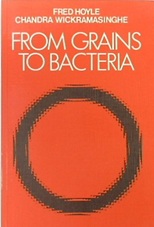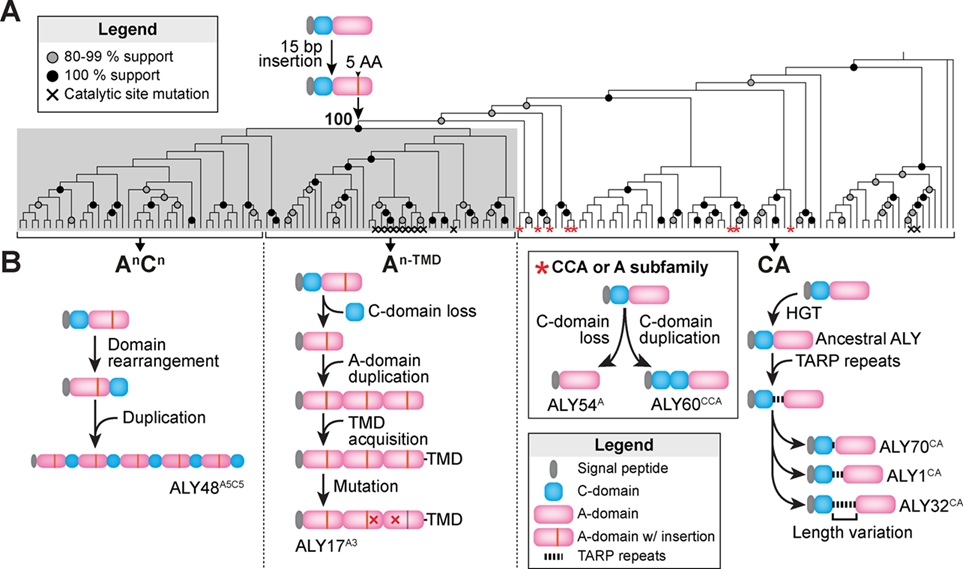...we present here complete, phased, diploid genomes of six ape species.... A large international team of genomicists, bioinformaticians and others, captained by Evan Eichler, has resolved many of the former difficulties in sequencing the genomes of humans and their near relatives. Now they have made those genomes available to all. One important benefit is ...the added value for standard evolutionary analyses.... For example, the figure below shows human chromosome 16 compared to the corresponding chromosomes (descending in the figure) in chimpanzee, bonobo, gorilla, Bornean orangutan and Sumatran orangutan. The green ribbons indicate "a single transposition [that] relocates about 4.8 Mb of gene-rich sequence in gorilla."
 Excellent. Here is extensive precise sequencing for relatively recent evolution. The sequences include hundreds of new candidate genes and regions to account for phenotypic differences among the apes. The transitions include insertions, relocations and inversions of large segments. Given the approximately known populations and time brackets, it shoud be possible, under neo-darwinian logic, to calculate the likelihood of the human evolution revealed here, particularly that of the "new candidate genes."
Excellent. Here is extensive precise sequencing for relatively recent evolution. The sequences include hundreds of new candidate genes and regions to account for phenotypic differences among the apes. The transitions include insertions, relocations and inversions of large segments. Given the approximately known populations and time brackets, it shoud be possible, under neo-darwinian logic, to calculate the likelihood of the human evolution revealed here, particularly that of the "new candidate genes."
 "Complete sequencing of ape genomes," by Yoo, D., Rhie, A., Hebbar, P. et al. (>100 authors), doi:10.1038/s41586-025-08816-3, Nature, 09 Apr 2025. "Complete sequencing of ape genomes," by Yoo, D., Rhie, A., Hebbar, P. et al. (>100 authors), doi:10.1038/s41586-025-08816-3, Nature, 09 Apr 2025.
 "What makes us human? Milestone ape genomes promise clues," by Humberto Basilio, Nature, 09 Apr 2025. "What makes us human? Milestone ape genomes promise clues," by Humberto Basilio, Nature, 09 Apr 2025.
 04 Jan 2016: Thousands of human and/or chimpanzee-specific genes are derived from previously silent DNA. 04 Jan 2016: Thousands of human and/or chimpanzee-specific genes are derived from previously silent DNA.
 30 Sep 2005: The chimp genome has been sequenced. 30 Sep 2005: The chimp genome has been sequenced.
 Human Genome Search describes an early, related project, begun Nov 2001. Human Genome Search describes an early, related project, begun Nov 2001.
 New genetic programs... describes a naive continuation of the project. New genetic programs... describes a naive continuation of the project.
 Robust Software Management: a system for managing insertions, relocations, inversions, etc. Robust Software Management: a system for managing insertions, relocations, inversions, etc.
 Thanks, Evan Eichler, 13 Apr 2025. Thanks, Evan Eichler, 13 Apr 2025.
Observations of interstellar extinction probably provide the most direct clues concerning the optical properties of interstellar dust. So wrote Chandra Wickramasinghe, in 1972, in a 500-page oversize reference book on the subject. Interstellar dust was a little-noticed topic, but, by then Wickramasinghe had spent ten years investigating it with Fred Hoyle. The book includes some history and many equations, but the bulk of it is columnar tables listing values of scattering functions and graphs of extinction curves for particles of different shapes and compositions. Wickramasinghe had become a world authority. No one had looked more carefully.
 Light-Scattering Functions for Small Particles, by N.C. Wickramasinghe, Adam Hilger, London, 1973. Light-Scattering Functions for Small Particles, by N.C. Wickramasinghe, Adam Hilger, London, 1973.
 Chandra Wickramasinghe has an early essay about evoltion, and many updates. Chandra Wickramasinghe has an early essay about evoltion, and many updates.
 In 1972, the sizes and shapes of the dust particles were still imperfectly known, and the composition might include graphite and water ice. As the research continued, more evidence for larger, life-related organics emerged, the size range narrowed, and clues about the dust's refractance began to converge. After almost 20 years, in 1981, Hoyle and Wickramasinghe reached an astounding conclusion — freeze-dried bacteria provided the best match, by far, for the dust. Initially, they were as surprised as anyone. A chronicle of this research, from 1962 to 1983 is available in a collection of 25 scientific papers and accompanying discussion. The story needs to be much better known; this record makes it hard to dismiss.
In 1972, the sizes and shapes of the dust particles were still imperfectly known, and the composition might include graphite and water ice. As the research continued, more evidence for larger, life-related organics emerged, the size range narrowed, and clues about the dust's refractance began to converge. After almost 20 years, in 1981, Hoyle and Wickramasinghe reached an astounding conclusion — freeze-dried bacteria provided the best match, by far, for the dust. Initially, they were as surprised as anyone. A chronicle of this research, from 1962 to 1983 is available in a collection of 25 scientific papers and accompanying discussion. The story needs to be much better known; this record makes it hard to dismiss.
 From Grains to Bacteria, by Fred Hoyle and Chandra Wickramasinghe, University College Cardiff Press, 1984. From Grains to Bacteria, by Fred Hoyle and Chandra Wickramasinghe, University College Cardiff Press, 1984.
 Hoyle and Wickramasinghe's Analysis of Interstellar Dust has background. Hoyle and Wickramasinghe's Analysis of Interstellar Dust has background.
 Fred Hoyle Interviewed... includes his account of their finding bacteria in space. Fred Hoyle Interviewed... includes his account of their finding bacteria in space.
| 03 Apr 2025 |
What'sNEW about HGT


|
...the diatom Nitzschia sing1 ...abandoned its original photosynthetic lifestyle, ...to thrive on algae derived sugars...[by acquiring] an alginate lyase gene from a marine bacterium. Once integrated into the diatom's genome, the ancestral alginate lyase underwent extensive duplication and diversification.... [A] significant functional shift in the ...enzymes was driven by a 15-base pair insertion, which restructured the enzymes' catalytic pockets to favor terminal cleavage rather than internal cutting.
According to cosmic ancestry, macroevolutionary advances become possible when genetic programming is acquired. The acquired sequence can be tested for ultimate deployment, silent retention, or rejection. Testing could include duplications, targeted insertions, deletions and recombinations. It might might even include "directed" point mutations for task optimization. Another example of HGT seems to neatly illustrate much of this testing and deployment.

 "A single enzyme becomes a Swiss Army knife," by Andreas Sichert, PLoS Biol, 02 Apr 2025; re: "A single enzyme becomes a Swiss Army knife," by Andreas Sichert, PLoS Biol, 02 Apr 2025; re:
 "Diatom heterotrophy on brown algal polysaccharides emerged through horizontal gene transfer, gene duplication, and neofunctionalization," by Zeng Hao Lim et al, doi:10.1371/journal.pbio.3003038, PLoS Biol., 01 Apr 2025; and: "Diatom heterotrophy on brown algal polysaccharides emerged through horizontal gene transfer, gene duplication, and neofunctionalization," by Zeng Hao Lim et al, doi:10.1371/journal.pbio.3003038, PLoS Biol., 01 Apr 2025; and:
 "...How a borrowed bacterial gene allows some marine diatoms to live on a seaweed diet," Phys.Org, 01 Apr 2025. "...How a borrowed bacterial gene allows some marine diatoms to live on a seaweed diet," Phys.Org, 01 Apr 2025.
 Robust Software Management is a proposed name for the operating system that tests acquired programming. Robust Software Management is a proposed name for the operating system that tests acquired programming.
 Viruses and Other Gene Transfer Mechanisms cites >1,000 examples of HGT into eukaryotes. Viruses and Other Gene Transfer Mechanisms cites >1,000 examples of HGT into eukaryotes.
According to neo-darwinism (including all modern variants), mutation-and-selection are sufficient to write new genetic programs leading to macroevolutionary advances. Where are the clear illustrations of that process?
 Testing Darwinism versus Cosmic Ancestry elaborates on this question. Testing Darwinism versus Cosmic Ancestry elaborates on this question.
![]()
|
 Excellent. Here is extensive precise sequencing for relatively recent evolution. The sequences include hundreds of new candidate genes and regions to account for phenotypic differences among the apes. The transitions include insertions, relocations and inversions of large segments. Given the approximately known populations and time brackets, it shoud be possible, under neo-darwinian logic, to calculate the likelihood of the human evolution revealed here, particularly that of the "new candidate genes."
Excellent. Here is extensive precise sequencing for relatively recent evolution. The sequences include hundreds of new candidate genes and regions to account for phenotypic differences among the apes. The transitions include insertions, relocations and inversions of large segments. Given the approximately known populations and time brackets, it shoud be possible, under neo-darwinian logic, to calculate the likelihood of the human evolution revealed here, particularly that of the "new candidate genes."
 In 1972, the sizes and shapes of the dust particles were still imperfectly known, and the composition might include graphite and water ice. As the research continued, more evidence for larger, life-related organics emerged, the size range narrowed, and clues about the dust's refractance began to converge. After almost 20 years, in 1981, Hoyle and Wickramasinghe reached an astounding conclusion — freeze-dried bacteria provided the best match, by far, for the dust. Initially, they were as surprised as anyone. A chronicle of this research, from 1962 to 1983 is available in a collection of 25 scientific papers and accompanying discussion. The story needs to be much better known; this record makes it hard to dismiss.
In 1972, the sizes and shapes of the dust particles were still imperfectly known, and the composition might include graphite and water ice. As the research continued, more evidence for larger, life-related organics emerged, the size range narrowed, and clues about the dust's refractance began to converge. After almost 20 years, in 1981, Hoyle and Wickramasinghe reached an astounding conclusion — freeze-dried bacteria provided the best match, by far, for the dust. Initially, they were as surprised as anyone. A chronicle of this research, from 1962 to 1983 is available in a collection of 25 scientific papers and accompanying discussion. The story needs to be much better known; this record makes it hard to dismiss.

![]() "A single enzyme becomes a Swiss Army knife," by Andreas Sichert, PLoS Biol, 02 Apr 2025; re:
"A single enzyme becomes a Swiss Army knife," by Andreas Sichert, PLoS Biol, 02 Apr 2025; re:
![]() "Diatom heterotrophy on brown algal polysaccharides emerged through horizontal gene transfer, gene duplication, and neofunctionalization," by Zeng Hao Lim et al, doi:10.1371/journal.pbio.3003038, PLoS Biol., 01 Apr 2025; and:
"Diatom heterotrophy on brown algal polysaccharides emerged through horizontal gene transfer, gene duplication, and neofunctionalization," by Zeng Hao Lim et al, doi:10.1371/journal.pbio.3003038, PLoS Biol., 01 Apr 2025; and:
![]() "...How a borrowed bacterial gene allows some marine diatoms to live on a seaweed diet," Phys.Org, 01 Apr 2025.
"...How a borrowed bacterial gene allows some marine diatoms to live on a seaweed diet," Phys.Org, 01 Apr 2025.
![]() Robust Software Management is a proposed name for the operating system that tests acquired programming.
Robust Software Management is a proposed name for the operating system that tests acquired programming.
![]() Viruses and Other Gene Transfer Mechanisms cites >1,000 examples of HGT into eukaryotes.
Viruses and Other Gene Transfer Mechanisms cites >1,000 examples of HGT into eukaryotes.